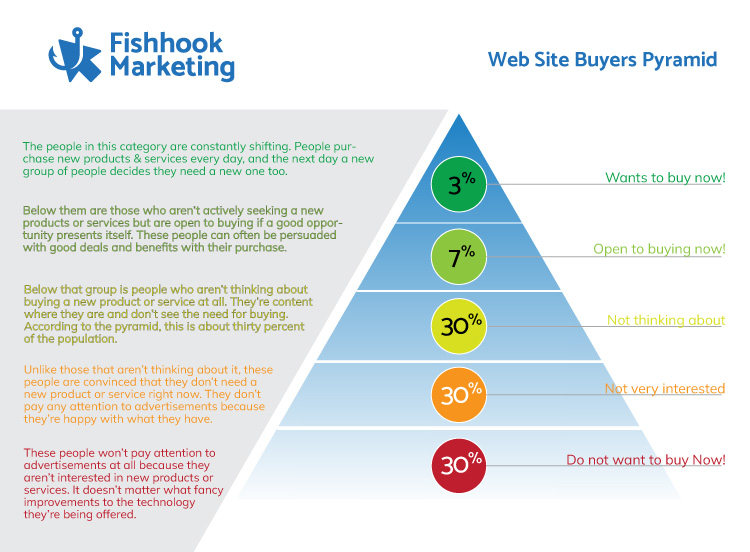79% of marketing leads don’t turn into sales.
It doesn’t matter how many sales calls you make or how many emails you collect. Unless you can turn those prospects into paying customers, your business will be stuck at the same stage forever.
And the reason you can’t convert those leads? It has nothing to do with how good your product or service is. A large part of this problem points to a faulty sales funnel. Or worse—not having any sales funnels at all.
But what if you’ve never heard of a sales funnel before? Or maybe you’ve tried to make one but it never got you results?
In this blog post, we’re going to take you from confused to convinced. Keep reading to learn all about what a sales funnel is, why your business needs one, and more.
What Is a Sales Funnel?
A sales funnel is the journey that your customers take on the way to buying your product or service.
In marketing terms, this means taking people from leads to customers. A lead is a person who might eventually become your customer.
Each step of the funnel means that your potential customer is one step closer to buying from you.
The sales funnel usually starts with creating awareness about your product or service. Then, it moves prospects down the funnel to learn more about your offering. Finally, your funnel turns these potential customers into paying customers.
You don’t need to be a fancy marketing company to have a sales funnel. Any company can (and should) have a sales funnel, including:
- Retail stores
- Cinemas
- Bakeries
- Personal trainers
- Dentistry offices
The process is called a funnel because you start out with many potential clients. As they go through your funnel, the pool of potential clients narrows into your pool of paying customers.
You can visualize the sales funnel as an inverted pyramid.
Sales Funnel Stages
Your leads will go through 4 main stages in your sales funnel:
- Awareness
- Interest
- Decision
- Action
In the awareness stage, your lead becomes aware of your product or service. They may start to research solutions to their problem online. They may also find your company through your online ad campaigns.
In the interest stage, your lead is interested in learning more about your product or service. They might visit your website or send you an email inquiry.
In the decision stage, your lead may be in several different sales funnels. This includes your competitors. At this stage, they’re deciding whether to choose your product or your competition’s.
To decide, they may look at online reviews, ask on social media, or ask friends for referrals.
And finally, your lead will make a purchase in the action stage.
A Sales Funnel Example
Let’s look at a simple sales funnel example.
You own a clothing store, and a customer goes into your shop (awareness). They see a sales rack for discount winter coats (interest).
They go through the rack, try on a few coats, and think about whether they can get a better deal somewhere else (decision). Finally, they decide they want one of your coats and go to the cashier (action).
Tips for Each Step of the Sales Funnel
For these tips, we’ll use another sales example. Let’s say you sell products that help students manage their time better. These include video courses, e-books, and planners.
During the awareness stage, you don’t want to be pushing your products. This will only turn potential customers away.
It’s true that some customers may love your offering and buy it right away. But more often, you’ll need to slowly convince them that your product is the right choice.
Once you’ve gotten their attention, you’re in the interest stage. You still don’t want to be too “salesy” at this point. Instead, your goal is to help the potential customer.
Build trust with them by showing your expertise. Even better is if you can give them a quick win.
For our student time management example, this could be a blog post on three quick ways to save time when studying for exams.
The decision stage that comes next is critical. Your ideal customer may be looking at your e-book and another company’s e-book. This is where you want to convince them to buy from you.
A few ways you can do this include:
- Offering free shipping
- Giving them a discount code
- Adding a bonus product like a workbook
If you already have their emails, you can send these bonuses that way. You can also configure your email marketing service to send discount codes when people leave a product in their cart.
Finally, you need to show your appreciation once your customer reaches the end of your funnel. The action stage is where you focus on keeping those customers.
Make sure to thank them for their purchase. You can also offer tech support, be there to answer questions, or ask them for feedback.
Why Businesses Need a Sales Funnel
In marketing, a touchpoint is when a potential customer comes into contact with your brand.
Most businesses need 8 touches to even get an initial meeting with a sales prospect.
For example, if you are a business coach, your potential clients will need to see your brand an average of 8 times before they book a discovery call with you.
These touchpoints could include:
- Going on your website
- Looking at product/service pages
- Reading a blog post
- Looking at your social media
- Reading a review
And even if they book a discovery call with you, your work isn’t over yet—you still need to make a sale. By having a sales funnel, you make this job easier for yourself as you have the customer’s journey planned out.
The Benefits of Sales Funnels
One of the biggest benefits of sales funnels is that they keep your sales strategy focused.
A scatterbrained approach that’s different with every client will only confuse you. A sales funnel helps you know exactly which steps you want your potential customers to take on their way to buying from you.
A good sales funnel also helps you get more sales. Once you’ve created your first few funnels, take a look at which sales strategies got people further down your funnel. Write down which ones didn’t work as well as you hoped.
Perhaps discovery calls worked really well at getting more paying clients, while your live webinars didn’t.
Once you’ve created a few sales funnels, you can use them to forecast how much revenue you’ll make. You can forecast this because you’ll have a good idea of how leads move through your sales funnel.
Maybe 5% of your email list signs up for your new programs, for example.
This helps you budget and decide on which programs/products to sell in the near future.
You can also look at each stage of the funnel and see what’s working and what’s not. This helps increase your profitability while spending less on marketing.
If you spend money on social media ads, check where leads are coming from. If most of your leads are coming from Facebook, you can cut down on other ads that aren’t getting you as many potential customers.
Effective Sales Funnels and What They Include
To make an effective sales funnel, you must design it specifically for your business. This includes the products/services you offer.
It also includes all the touchpoints you need to get leads from awareness to action.
If this is your first sales funnel, you won’t have any data to start from. Use a sales funnel template to help you get started.
You also want to take a look at what other successful businesses in your industry are doing.
Go to your competitor’s websites and pretend you’re a customer. How did you become aware of the business? What would make you want to buy from them? How are they offering value (even for free)?
An effective sales funnel is also tailored to your ideal customer.
This means that it will include content and offers that are relevant and appealing to them.
Finally, an effective sales funnel is continually optimized. This is based on the data you collect as your leads move through your funnel. You’ll have this data as soon as you launch your first funnel.
You can use this data to improve the funnel’s effectiveness and increase sales.
How to Create a Sales Funnel
Learning how to create a sales funnel may be overwhelming at first, but it gets easier the more times you do it.
You can set up a sales funnel in 5 steps:
- Create a landing page
- Give value
- Create an email campaign
- Encourage them to buy
- Follow up
Let’s look at each of these steps in detail.
Creating a Landing Page
The first step in your marketing sales funnel is creating a landing page for your product or service.
A landing page explains what your company and product are all about. Potential customers will get to your landing page when they click on your ad. They can also get to it if they sign up for your webinar or click to download your e-book.
One of the main purposes of your landing page is to get people’s email addresses. You’ll need this to communicate with potential customers later.
Remember that you need to get people’s attention if you want them to get to your landing page at all. To do this, put your content out where your target audience can see it.
You can also run ads on the social media platforms your target audience uses.
Give Value
In exchange for people’s email addresses, you want to give them something valuable.
For example, your landing page could include a link to download your free e-book in exchange for their email address.
This is the stage where you build trust and show your expertise.
Create an Email Campaign
Next, use email sequences to give even more value to people. Write email content that speaks to your target customers’ pain points and show them how your product or service can help.
This is called an email drip campaign. Drip campaigns are time-based, automated emails. For example, your drip campaign could be three emails (one for each week).
Remember that people who’ve just signed up to your email list aren’t usually ready to buy from you. The drip campaign will help them get to know your company and trust you.
Drip campaigns also save you time. You only write them once, and then they’re automatically sent to new subscribers.
Encourage Them to Buy
Now that you’ve built up enough trust, it’s time to offer them your product. To inspire leads towards the “action” stage, this offer needs to be amazing.
This is where you want to offer a discount, a free trial, or a huge bonus. You can also make this a time-limited offer to encourage people to take quick action.
Follow Up
There are two ways to follow up when people have reached the end of your sales funnel.
For new customers, focus on engaging them with gratitude and ideas for how to use their new product. For example, you can offer them product tutorials or give them coupon codes for future purchases.
If someone didn’t buy your product, create another automated email sequence for them. Keep in touch with them. They may not have been ready to buy your product right now, but they might want to in the future.
Don’t forget to keep an eye on your conversion rates. This will help you tweak your sales funnel to be even more effective in the future.
Ready to Create Your Own Sales Funnels?
Creating sales funnels is a necessity for any business that wants to get serious about generating leads and sales.
And when you work on creating relationships with potential customers, you build trust over time. This reduces doubt or hesitation when they decide to buy something from you!
Still confused about how to create your own sales funnel? Fishhook Marketing can help. Our extensive business expertise means we’re well-equipped to help you convert visitors into paying customers.
Ready to learn more? Book a marketing consultation with us today!








